Authors
Aidan Foster-Carter

Aidan Foster-Carter is an honorary senior research fellow in sociology and modern Korea at Leeds. He is also a freelance analyst and consultant: covering the politics and economics of both South and North Korea for, amongst others, the Economist Intelligence Unit, Oxford Analytica, and BBC World Service. Between 1991 and 1997 he lectured on sociology at the universities of Hull, Dar es Salaam (Tanzania), and Leeds. A prolific writer on and frequent visitor to the Korean Peninsula, he has lectured on Korean and kindred topics to varied audiences in 20 countries on every continent. He studied Classics at Eton, Philosophy, Politics, and Economics at Balliol College Oxford, and Sociology at Hull.
Articles by Aidan Foster-Carter
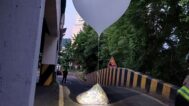
North Korea - South Korea
May — December 2024Rubbish Balloons, Mutual Repudiation: Is This How It Ends?
Inter-Korean relations, already bad, got worse in 2024. North Korea launched a bizarre new campaign, sending balloons bearing trash. South Korea reacted by fully suspending the already defunct North-South military pact and resuming propaganda broadcasts at the DMZ. In August, ROK President Yoon Suk Yeol announced a new policy of unification under liberal democracy, which despite offering dialogue left no place for the DPRK or Kim Jong Un. The latter took umbrage at Seoul for exaggerating flood casualties in the North, but offered no figure of his own. It is unclear whether North Korea has revised its constitution to declare South Korea irredeemably hostile, as no text has been published. In October the North blew up inter-Korean road and rail links. In December. Yoon blew up his own presidency by briefly declaring martial law, plunging South Korea into political chaos. As of now the North has not taken advantage of this.
New Northern Dirty Tricks: What A Load Of Rubbish!
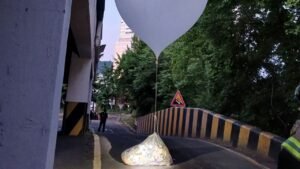
Figure 1 Balloons full of trash and filth from North Korea are seen in south Chungcheong province, South Korea. Photo: CNN
The main inter-Korean news during the period under review was a new dirty tricks campaign— literally—by Pyongyang. Since late May, North
Korea has launched between 6,000 and 9,000 missiles of a new kind across the Demilitarized Zone (DMZ). Fortunately none bore explosive warheads or flew at supersonic speeds to rain death and destruction on the South. Instead they floated slowly through Southern skies, before depositing unpleasant but at worst mildly harmful payloads of a most peculiar kind: assorted rubbish.
Some background first. As regular readers know, North Korea has long bridled at Southern activists, some defectors, who launch helium balloons into the North laden with anti-DPRK propaganda; cargoes can also include medicines, dollar bills, memory sticks, and more. This became a political issue in South Korea when the previous liberal administration of Moon Jae-in in 2020 controversially banned such launches, though in practice they continued. Under Moon’s conservative successor Yoon Suk Yeol, the Constitutional Court struck down that ban in September. 2023 as infringing freedom of speech. Activist NGOs like Fighters for a Free North Korea (FFNK) duly redoubled their efforts, infuriating the North, which vowed to retaliate.
Now it is doing so. The context is important. Weird as North Korea’s action seems, this is not random in at least two ways. Sending rubbish echoes and mirrors the North’s characterization of Southern balloon cargoes as rubbish sent by “human scum.” Indeed, Pyongyang gave notice in advance, unusually. After yet another balloon launch by FFNK on May 10, DPRK Vice Defense Minister Kim Kang II warned: “Mounds of wastepaper and filth will soon be scattered over the border areas and the interior of the ROK, and it will directly experience how much effort is required to remove them.” Two days later he was as good as his word.
Official DPRK statements consistently framed this as giving the South a taste of its own medicine. Kim Kang Il followed up on June 2: “We made the ROK clans (sic) get enough experience of how much unpleasant they feel and how much effort is needed to remove the scattered wastepaper.” (For full quotation and more detail, see the Chronology.) Subsequent waves of Northern balloons have also been portrayed by Pyongyang as ripostes for Southern actions, since needless to say FFNK and their ilk have continued their own launches.
What to make of this odd turn? Some figures first. According to Beyond Parallel, a DPRK focused website which has been keeping score, as of Nov. 29—after almost exactly six months of this—North Korea had sent between 6,430 and 8,950 trash-filled balloons into South Korea, on 32 occasions (they are launched in batches, not continuously). Of these, 3,147— between a third and half—landed successfully, in 3,359 locations nationwide (so the latter figure, being higher, must include unsuccessful landings, whatever that means). The great majority came down in Seoul and the surrounding Gyeonggi province, but some have reached every ROK province except South Jeolla and Jeju island.
Rubbish comes in many forms, and payloads have varied. In Beyond Parallel’s summary, “These balloons have been found to contain trash such as animal and human feces, batteries, cigarette butts, clothes, dark soil, plastic bottles, toilet paper, wastepaper, and vinyl.” The nastier stuff was mainly earlier on. Fears at one point of disease-bearing vectors proved groundless. Some soil was found to contain parasites like roundworms, whipworms, and threadworms, reflecting the fact that North Korea largely uses human feces as fertilizer.
Seoul reacted with understandable anger. On June 2 National Security Adviser Chang Ho-jin threatened Pyongyang with “unendurable” consequences for its “despicable provocations that could not have been imagined by a normal country.” This was after a second wave, whose cargo included cigarette butts, paper, and plastic bags—but no more poop. In addition to the filthy balloons, for four days (May 29—June 1) the North tried to jam GPS signals near ROK islands in the West/Yellow sea, causing glitches to some vessels’ navigation systems. Another brief bout of GPS jamming followed in November.
On June 4 South Korea responded in deed as well as word, by fully suspending 2018’s inter-Korean tension reduction agreement. Pyongyang had already repudiated the whole accord, after Seoul partially suspended it in November. For the ROK, full suspension meant it could resume previously banned military exercises and other activities near the DMZ, which it duly did. On June 26 the ROK Marine Corps staged its first live-fire drills for seven years on Yeonpyeong and Baengnyeong islands in the West/Yellow Sea, which lie close to the DPRK. Live-fire artillery drills on the mainland near the DMZ resumed on July 2.
After another wave of Northern balloons, Seoul took further action. On June 9 it reinstalled loudspeakers at the DMZ and resumed propaganda broadcasts, for the first time since 2016. The speakers blared for just one day in the first instance. But in July, as the balloons kept coming the speakers were turned on again, for longer and more often.
In due course the North riposted with loudspeakers of its own; only once again—as per the balloons—in a weird way. Rather than propaganda, Southern residents in some areas near the DMZ were disturbed and kept awake by very loud eerie howling and other strange sounds. At this writing (early December.) both sides were continuing their respective aural bombardments.
Floods Rattle Kim: He Takes It Out on Seoul
In late July northern North Korea was hit by severe floods. In itself that would be a domestic event, all too familiar in the monsoon season given the impoverished DPRK’s failure to invest in the necessary infrastructure—although Kim Jong Un’s response was to scapegoat and sack officials rather than admit this system failure. But there is also an inter-Korean dimension, indeed two. Seoul naturally offered aid, and was ignored. (When Putin did the same, Kim thanked him politely but said they will manage on their own.)
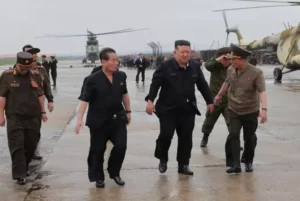
Figure 2 North Korean leader Kim Jong Un inspects a flood-affected area in North Pyongan Province, North Korea, on July 28. South Korean media has estimated the number of dead or missing to be over 1,000. Photo: Korean Central News Agency
The other, more intriguing connection is that Kim used part of a long speech to flood victims to vent his spleen against South Korea (see Appendix I). His whole response to this disaster is revealing of the dilemmas he faces and the strategies he adopts. On the positive side, as also seen in other areas such as failed satellite launches—there was another of those, promptly admitted, on May 27, just before the balloon launches began—this Kim does permit a bit more glasnost than his father or grandfather. The floods were reported, and some material damage was detailed. State media portrayed a concerned leader on the spot: risking his shiny new Maybach SUV in wheel-high floodwaters, or looking grim and getting soaked as he toured the area in an open rubber dinghy. One remarkably candid shot showed him ducking to avoid being thwacked by an overhanging branch on a watercourse that used to be a road.
But there are limits. DPRK media gave no casualty figures, although satellite photos showed considerable devastation—including at least one entire village swept away. Naturally, South Korean media and the ROK government sought to assess this aspect as well. On Aug. 1 TV Chosun quoted an ROK official as estimating that up to 1,500 people perished, “including rescue workers who died from over-exertion.” MOU concurred that there must have been “considerable casualties,” while noting that material damage appeared less than in previous floods in 2010, 2016, and 2020.
Such claims clearly got Kim’s goat. I suggest you read Appendix I now. As you do, ponder thousands of sodden flood victims, herded to listen to a typically long speech. Must they not have wondered, as you may too, why he was banging on about South Korea so much? And how did they react when he revealed that Southern claim of over 1,000 casualties? They would never have known that, had the Leader not said it, though rumors doubtless swirled. He did not say what the true figure was. Yet we know there were casualties, for elsewhere Kim admitted this. Sacking two party secretaries and the minister of Public Security on July 29, he said their neglect of flood prevention “caused even the casualty that can not be allowed.”
When you’ve just lost everything, being told over and over to hate South Korea is hardly the message you expect or want or need to hear. But that is evidently what was on Kim’s mind. Having to ram it home suggests that this message is encountering some skepticism, as well it might. (No mention, needless to say, that the evil ROK had actually offered to help.)
Yoonification Under ‘Liberal Democracy’: Bye Bye DPRK!
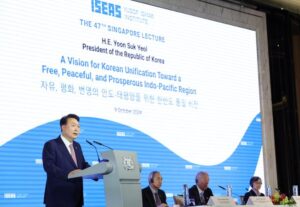
Figure 3 President Yoon Suk Yeol delivers the 47th Singapore Lecture on “A Vision for Korean Unification Towards a Free, Peaceful and Prosperous Indo Pacific Region” at a hotel in Singapore, Wednesday. Photo: Yonhap
In Seoul, meanwhile, President Yoon was preparing to announce what was trumpeted as a wholly new vison of Korean unification. He duly did so on Liberation Day (from Japanese rule in 1945), Aug. 15, a public holiday in both Koreas. What wags dubbed ‘Yoonification’ was indeed new. Hitherto, the varied stances adopted by ROK governments in the post-1987 democratic era all shared some version of a process by degrees. The end-point was reunification, but the starting point here and now had to be the two existing states. So the first step must be dialogue between Seoul and Pyongyang, leading over time to reconciliation.
Yoon wanted no truck with any of that. Despite a pro forma offer of talks, which many media misleadingly headlined—Reuters, Bloomberg, Nikkei, DW—did you not read the full speech? — his core message was uncompromising: unification under liberal democracy. His words left no room for doubt or indeed dialogue. “The freedom we enjoy must be extended to the frozen kingdom of the North, where people are deprived of freedom and suffer from poverty and starvation.” True enough—but what exactly does that leave for Kim Jong Un to discuss?
NK News, by contrast, got the true message exactly right in its headline “ROK president makes no room for Kim Jong Un in a unified Korea. Yoon’s call for unification under democracy makes North Korean regime change unspoken goal, aiming to divide its society.”
In its own way, this stance is no less hostile toward North Korea as a state than Kim Jong Un’s new doctrine of South Korea as an implacable foe. One big difference is that Yoon recognizes North Koreans as fellow-Koreans: a truer and more logical stance, which also gives Seoul the moral high ground. Kim rages against the ROK as a state, says the DPRK is entitled to destroy it, but is silent on how 52 million South Koreans fit into this malevolent vision. They are no longer kin or compatriots, so perhaps they don’t count. As discussed in our last article, this is one of several ways that Kim’s doctrine makes no sense.
SPA Damp Squib
Clarification had been anticipated in October, when the Supreme People’s Assembly (SPA) — North Korea’s rubber-stamp Parliament, as it is often correctly tagged—was due to meet in order (inter alia) to revise the DPRK Constitution to reflect the new line on the South, as Kim had announced earlier in the year. Much attention was focused on this, to see how the changes would be worded. Kim had also spoken of clarifying territorial borders, threatening fire and brimstone should any foe cross them. This naturally raised fears of renewed tensions in the West/Yellow Sea around the Northern Limit Line (NLL), the de facto maritime boundary.
In the event this proved a damp squib, or perhaps a pig in a poke. The SPA duly met on Oct. 7-8, but went unreported until afterward. Kim did not attend, instead giving a speech at what—in a further sign of his growing personality cult in his own right—is now renamed Kim Jong Un University of National Defense. Subsequent brief reports suggest that the SPA did indeed revise the Constitution, but as of December the new text has yet to be published.
This silence looks like a retreat. It is a stretch to imagine how one would draft such an absurd and incoherent notion into a Constitution. Chad O’Carroll of NK News suggests two different possible motives: domestic opposition to Kim’s new anti-unification policy and Pyongyang’s preference for strategic ambiguity, to keep its enemies guessing. Both may well be true.
North Delinks From South, Explosively
But maybe for Pyongyang actions speak louder than words. Never mind redrafting, let’s just stage an explosion! A week after the SPA met, on Oct. 15 North Korea ceremoniously blew up the roads and railway tracks—two of each, in the east and west of the peninsula—which in happier times earlier this century had physically reconnected the two Koreas (all paid for by Seoul, needless to add). True, this had been a very limited relinking. No regular train services ever ran, and the eastern road was only briefly used to ferry Southern tourists to the Mount Kumgang resort before tours were suspended in 2008 after a middle-aged female visitor was shot dead. The western road saw more use, as Southern businesses trucked supplies in and finished goods out from the Kaesong Industrial Complex (KIC), which lasted until 2016. But no further. Except for rare high-level meetings, no one drove between Seoul and Pyongyang.
Those seeking consolation may note that the destruction is symbolic too. In some future thaw, unimaginable currently, these now severed arteries could easily be reconnected. Interestingly, the ROK Joint Chiefs of Staff noted that the visually impressive large mounds of earth which the North has piled up to fortify the blockage are not militarily effective ramparts, much less the tank traps they claim. But they look good on camera. Here, as often, North Korea seems content with merely symbolic histrionics. We should be thankful Kim settles for that.
Yoon Loses The Plot—And His Job?
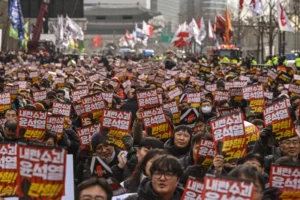
Figure 4 Demonstrators from a labor group take part in a protest calling for the ouster of South Korea President Yoon Suk Yeol outside City Hall in Seoul on Dec. 12, 2024. Photo: ANTHONY WALLACE/AFP via Getty Images
North Korea is often described as unpredictable: led by an isolated and unloved ruler, whose paranoia might tempt him to misjudge situations and lash out. Wrong Korea, it would seem.
As I write, the political chaos unleashed by Yoon Suk Yeol’s mad declaration of martial law (swiftly rescinded) on Dec. 3 is ongoing. While primarily about South Korean domestic politics, this has clear implications for inter-Korean relations. This dismal affair is obviously negative for the ROK’s security: exposing weaknesses that Kim Jong Un might see as vulnerabilities. While we do not share the view that Kim is bent on all-out aggression—pin pricks and gestures are more his bag—in principle he may seize such a golden opportunity to exploit Yoon’s and South Korea’s discomfiture. But as of this writing, he has not done so.
More specific issues also arise. Glad as we may be in this instance that some senior military commanders apparently refused or ignored orders they deemed unwarranted or even illegal, thereby ensuring a peaceful denouement, chains of command need to function properly and reliably. The subsequent formal power vacuum is also troubling. On Dec. 11, with Yoon sidelined but not yet impeached, who is South Korea’s commander-in-chief?
Also, crucially, the North was Yoon’s avowed excuse, however specious, for what he did. In his own words: “I declare martial law to protect the Republic of Korea from the threats of North Korean communist forces, to immediately eradicate the unscrupulous pro-Pyongyang anti-state forces that pillage the freedom and happiness of our people and to protect free constitutional order.”
It is a familiar rightwing McCarthyite ploy to smear democratic liberals as crypto-commies. There was in fact no specific DPRK threat. The same pretext may have been cited to soldiers involved, perhaps to pre-empt any doubts they might have. An opposition lawmaker claims that 2.5 hours before Yoon declared martial law, the ROK Army’s 707th Special Mission Group—the same unit sent to the National Assembly shortly after—received orders saying “the situation regarding North Korea is serious, and immediate deployment may be required.”
Moreover, as B R Myers notes in a typically contrarian commentary, rumors of a possible declaration of martial law had swirled since September—but were dismissed as leftist paranoia. While the full truth must await the multiple investigations now under way in Seoul, this casts a new light on a drone which dropped leaflets on Pyongyang in early October. The possibility cannot now be ruled out that Yoon— or his (now ex-) defense minister and schoolmate Kim Yong-hyun, the seeming brains (if that is the word) behind what increasingly looks like an attempted coup—deliberately sought to antagonize the North, in hope of provoking a reaction which they could then use to justify abolishing democracy (in order to save it, of course).
As for North Korea, they waited a week to comment, perhaps as bemused as the rest of us. On Dec. 11 the party daily Rodong Sinmun finally carried quite a detailed factual account, albeit peppered predictably with phrases like “puppet.” We reproduce this in full as Appendix II.
One can only wonder what North Korean readers are making of all this. Their government has just told them that in enemy South Korea there is a political opposition; you can come out on the streets in protest and denounce the leader, and he may yet fall. Those are heady thoughts to ponder in Pyongyang, even if none can be safely uttered aloud.
Sunrise, Sunset: A Roller-Coaster Quarter Century
As this is the final issue of Comparative Connections in its current form, it seems apt to stand back from immediate events and try to frame the bigger picture. What is the overall story of inter-Korean relations in the first quarter of the 21st century? And what are the lessons?
Let us remind ourselves of the main events. The century, and these articles, began with the radically new “Sunshine” policy pursued by Kim Dae-jung (ROK president 1998-2003), who sought to end decades of North-South hostility. The name derives from an Aesop fable, where sun and wind compete to make a man take off his coat. Warm sun triumphs over chilly wind.
For a decade under Kim and his fellow-liberal successor Roh Moo-hyun (2003-08), each of whom went to Pyongyang for summits with the North’s then leader Kim Jong Il—who never repaid the compliment by visiting Seoul—the two Koreas took baby steps, if giant-seeming compared to the past, to interact and reduce tensions. Two joint ventures, financed by the South, were built on Northern soil. From 1998 to 2008 1 million South Korean tourists visited scenic Mount Kumgang on the east coast: first by boat, but later by bus or car through the hitherto impassable Demilitarized Zone (DMZ), staying in Southern-built facilities. Near the west coast, the Kaesong Industrial Complex (KIC, 2004-16) at its peak saw some 120 mostly small ROK companies employ over 50,000 DPRK workers to make various goods for South Korean and overseas markets.
In 2008 South Korean voters turned right. Two conservative Presidents—Lee Myung-bak (2008-13) and Park Geun-hye (2013-2017)— were skeptical of Sunshine. Lee decided not to implement any of the numerous new joint ventures agreed by Roh at the second North South summit in 2007, near the end of his presidency (South Korean presidents serve a single five-year term). Presumably in reprisal, in 2010 the North sank the Southern corvette Cheonan with 46 deaths—Pyongyang denies responsibility—and shelled a Southern island, killing four. Lee retaliated by banning inter-Korean trade, with the large exception of the KIC. That JV continued till 2016, when Park abruptly shut it down after Pyongyang launched a satellite. Park Geun-hye’s impeachment gave Sunshine a second chance, as Seoul’s pendulum swung left again (for reasons unconnected to North Korea).
Her liberal successor Moon Jae-in (2017-22) had visited Pyongyang as Roh’s chief of staff. 2018 appeared an annus mirabilis, starting with Northern participation (in hastily formed pan Korean teams) in the Pyeongchang Winter Olympics. The North’s leader Kim Jong Un, who for his first six years after inheriting power in late 2011 on the death of his father Kim Jong Il had met no other foreign leader, emerged on the global stage in a whirlwind of summitry: meeting Moon three times, the same with Xi Jinping of China, and a first ever US-DPRK summit with Donald Trump, held in Singapore.
But after the second Trump-Kim summit (held in Hanoi in early 2019) collapsed, Moon’s reward for being an assiduous go-between was to be shunned by Kim and dissed by Trump. Though Moon insisted until the end of his term that a North-South peace process continued, the fact is that there have been almost no direct inter-Korean contacts for almost six years. (And yet these updates have never lacked issues to discuss.)
The latest ROK presidential election, in March 2022, narrowly voted in a conservative of a different kidney from Lee or Park, each of whom intermittently pursued dialogue with the North (not always publicly). Yoon Suk Yeol, a prosecutor new to politics, made an initial perfunctory “audacious offer” of aid, but soon showed he had no more interest in dealing with Kim than vice versa. As discussed above, his vision of unification has no room for the DPRK. Meanwhile the North sends trash balloons. We have come a long way since 2000: backward.
Was Sunshine Moonshine?
With chilly winds blowing colder than ever, it is tempting to conclude that sunshine failed. Certainly, that era is over for the foreseeable future, partly due to wider geopolitical changes beyond our bilateral remit here: China’s hardening under Xi Jinping, and Kim’s enthusiastic new military support for Russia in Ukraine. Yet the value of Comparative Connections is to have provided a granular, blow by blow account of events as they unfolded. I hope scholars and policy-makers will mine this archive carefully, before rushing to a priori or superficial conclusions. Here are my own tentative thoughts, looking back.
Indeed, Sunshine had grave flaws and issues, which must be acknowledged. Let us list some:
- It was exceedingly one-sided. Seoul did all the running and paid all the bills.
- Initially it included large secret payments, which not only broke ROK law but could be seen as enabling Pyongyang’s nuclear program.
- Very little was actually accomplished in any sphere. This encounter was marginal at best.
- Fundamental security issues, notably DPRK WMD, went unaddressed. North Korea’s first nuclear test, and subsequent ones, occurred during and despite Sunshine.
- Also unaddressed were North Korea’s appalling human rights abuses, as a corollary of respecting each other’s systems.
These are major negatives. Looking back, no one could claim that Kim Dae-jung’s Aesopian gamble worked out as he hoped. Hawkish skeptics, who from the start dismissed Sunshine as moonshine, may well feel vindicated. Undeniably, at no point did either Kim Jong Il or Kim Jong Un take major tangible—much less irreversible—steps to signal true reciprocity or an unmistakable willingness to change.
Many such would have been possible. Imagine, for instance, if reunions of separated family reunions had been genuine—in towns, unchaperoned, for longer, more often and on a larger scale—rather than the ghastly brief media-driven blub-fest mockery that they became. Or if that be deemed too risky, as the Kims evidently judged: Imagine if trains and trucks had actually run on the reconnected cross-border roads and railways, rather than these remaining unused and merely symbolic. A little more courage from the North could have seen the sinews of a reunified Korea begin to be built, in cumulative ways not easily reversible.
That was the road not taken. Above all, the fact that Sunshine coincided with growing global concern about the DPRK’s nuclear ambitions was fateful, and ultimately fatal. Pyongyang’s refusal to abandon its nuclear quest inevitably set limits to how far South Korea, a US ally hosting US bases and troops, could go on the inter-Korean front. One such moment came in Feb. 2016, when Park Geun-hye closed the KIC—not for any inter-Korean reason, but to punish Pyongyang for a satellite launch. Some might deem that an over-reaction: shutting down the last area of concrete North-South cooperation, for extraneous reasons.
Should we therefore conclude that Sunshine was misguided from the start? Was its net effect merely to enable or even strengthen a malign, cynical regime: happy to pocket ROK money, but which never had any intention of giving anything back, much less abandoning its WMD?
Historical counterfactuals (“what if …?”) have their limits, but perhaps lessons may be learnt. What if more substantial inter-Korean economic relations had been built, like for instance those between China and Taiwan? As that case shows, such ties do not eliminate military risk but they certainly mitigate it. Bluntly, Xi Jinping will think twice before damaging TSMC.
The detail afforded by Comparative Connections enables us to zero in on key moments and episodes. 2008 still seems to me a turning point. What if South Korea’s incoming President, Lee Myung-bak, had gone ahead with the economic joint ventures inked by his predecessor Roh Moo-hyun? The structural links thus created would have made the North increasingly dependent on the South economically, a valuable card on many levels, not least in building constituencies in Pyongyang with a solid material interest in inter-Korean betterment. As it was, and as I wrote elsewhere some time ago, South Korea lost the North to China.
This relates to another clear lesson. Regardless of Pyongyang’s intentions, a big problem was South Korea’s failure—unlike West Germany, back in the day—to craft and implement a bipartisan Nordpolitik: one which could endure despite the frequent changes of government in Seoul. Policy continuity is admittedly easier for dictatorships. But if DPRK archives are ever unsealed so we can read the discussions, I bet we’ll find their hawks raising a perfectly fair point: How can you make a deal with the South, when their next government might tear it up?
For all these reasons, bilateral inter-Korean relations, fitful and incipient as they were, never became more than a dependent variable in the broader regional and global geopolitical picture, at the mercy of extraneous events and developments. I still reckon that North-South ties, if better handled, could in principle have become a driver—but it didn’t happen. Looking Ahead: Never Say Never!
So much for the past. What of the future, which sadly I shall no longer be chronicling and analyzing here? Murky though current prospects look, let me venture a few thoughts.
First, the point just made applies in spades. In the short term, more than ever inter-Korean ties will be subject to wider geopolitical developments. Three in particular loom large. Kim Jong Un’s ever deepening commitment to support Putin’s aggression in Ukraine, now with boots on the ground, has profound ramifications which are beyond our scope here. Second, the imminent return of Donald Trump to the White House is a wild card. In his first term Trump successively pursued two opposite North Korea policies: from sneering at ‘little rocket man’ to bromance. Which will he plump for this time? And third, South Korea’s sudden political crisis means that at this writing it is unclear—if increasingly unlikely—that Yoon Suk Yeol will serve out his presidential term. Progressives already looked likely to regain power in Seoul after Yoon, but that could now happen in 2025 rather than 2027—in which case the ROK’s Nordpolitik will change drastically, yet again.
Another lesson: Never say never in Korea. As of now, both Korean governments have taken mutual hostility to the point of formal repudiation—but that can turn on a dime. Should the opposition Democrats (DPK) form the next ROK government, they will certainly reject Yoon’s hard-line stance and revert to some form of outreach (hopefully having learnt lessons from Moon Jae-in’s misguidedly one-sided bending over backward toward Pyongyang.)
If that happens, how will Kim Jong Un respond? Having gone so far as to define the ROK as an enemy state in the DPRK Constitution, any U turn could be difficult and embarrassing. Nonetheless, should Ukraine become an unpopular quagmire and Putin’s friendship prove limited and transactional, them given North Korea’s poverty and permanent economic crisis (self-inflicted by Kim’s refusal of market reforms), the lure of a rich and generous neighbor ready once again to wave checks—not blank, but substantial—may prove hard to resist, not least as counterweight to an increasingly irritated Beijing. Moreover, should Trump pick a fight with Seoul over payments for USFK, as he has threatened, any resulting spats may afford the ROK more flexibility than in the past to go its own way in dealing with Pyongyang.
Extending our gaze to the medium- and longer term, further issues loom. Kim Jong Un’s health remains a concern. If he drops dead tomorrow, that could unleash a power struggle in Pyongyang with alarming ramifications. Old hypothetical questions, never answered, would arise anew, starkly and for real. If there were chaos in North Korea, would South Korea and/ or China intervene: to secure the North’s loose nukes or perhaps restore order more broadly? If so, would Seoul and Beijing consult first—or might they, and the US, once again confront each other on the peninsula? One hopes there are agreed contingency plans, but I fear not.
Absent such collapse, more likely North Korea will limp on—but with an ever more restive populace, well aware that South Koreans live better and increasingly discontented with their own poverty and unfreedom. As Kim Jong Un’s early pledge that they will no longer have to tighten their belts rings ever hollower, and youths are shot for watching South Korean movies, the control and stability the DPRK has always achieved hitherto cannot be taken for granted. Future South Korean governments, and their citizens, may need to brace for contingencies and decide whether these constitute threats or opportunities.
There I shall leave it—and leave you, dear readers. It has been a privilege to spend the first quarter of this century chronicling the vicissitudes of inter-Korean relations for Comparative Connections. Whatever the future holds, I hope the archive thus created will prove useful to future scholars, policy makers and others. Let me conclude with Gramsci: Pessimism of the intelligence; optimism of the will. History is not foreordained. Korean reunification may be beyond reach, but inter-Korean reconciliation is still possible—and well worth striving for.
Appendix I
Excerpt from speech by Kim Jong Un, headlined: “Respected Comrade Kim Jong Un Clarifies in His Speech Stand of Party and Government on Repairing Flood Damage and Consoles Flood Victims”, KCNA 10 Aug. 2024
Comrades,
It is necessary for us to impress on our mind once again that the current rehabilitation project is not simply an undertaking for our own but also a serious struggle against the enemy.
At present, the enemy, misusing the occasion when we have suffered damage, is continuing to make foolish attempts to tarnish the image of our state.
It is important to inform Party organizations and working people’s organizations at all levels, various networks of education and the people of these facts and thus make them have a correct understanding of the ROK scum bordering on us.
The rubbish ROK’s media are desperately slandering all the socialist benefits and measures taken by our Party and government for the flood victims and also the communist traits displayed throughout the society, abusing them as a means of achieving some sort of internal unity and a type of demonstration. They are also fabricating such false information, in their frantic maneuvers to slander our government and system, that the missing persons in the afflicted areas exceed 1,000 in number and that its intelligence authorities found out that several helicopters had fallen on rescue mission.
Worse still, they are spreading a baseless rumor that the V-day celebrations took place in Pyongyang on the 27th of last month when loss of life occurred in the flood-hit areas.
Because the rumor is in wide circulation in the ROK society that its government is always late in coping with all sorts of accidents that happened there and such is an everyday occurrence in the country, they seem to weave absurd sophistry that slanders and slights us in an attempt to coax their citizens and stir up world public sentiments.
When I visited the helicopter unit that rescued you, I gave full account of the rescue operation, including the crash-landing by one helicopter during the operation, and expressed my gratitude that there had been no casualties in the turmoil.
The enemy even went so far as to say that I reacted personally to the report fabricated by their media because there were heavy casualties, I intended to cover it up.
What is their dogged insistence on making you, safe and sound like this, missing or dead? It is an open and shut case.
This is a smear campaign and a grave provocation against our state as well as an insult to you.
I have reason and feel it necessary to say this about the media of the dirty, rubbish country.
There is no need for us to make separate materials for education. It is because these clear facts are actual and educational materials good enough to clearly bring home to the people how filthy the enemy clan is, what ancient and old-fashioned way they resort to for fabrication and political smear campaign to tarnish the image of our state, what their ulterior motives are and why we call the enemy the enemy and scum.
No country in the world has such media which does nothing but to invent groundless and exaggerated lies.
What we must clearly realize is that the enemy is what we see them now.
Referring to these actual facts, the whole country should have a correct understanding of the enemy and cultivate a correct feeling against them.
Our enemy is an unchangeable enemy.
We should make the current opportunity, which helps us to have a correct understanding of what our enemy is, an opportunity of having a correct stand towards the enemy.
Appendix II
The DPRK’s first comment on the martial law crisis in South Korea
Headline: In the puppet Korea, social unrest expands due to martial law, more than 1 million people across the country take part in protests demanding the impeachment of Yoon Seok yeol, the international community is keeping a close eye on it.
Rodong Sinmun, 11 Dec. 2024, page 6 (unofficial translation)
The puppet Yoon Seok-yeol, who is facing a serious crisis of governance and impeachment, declared martial law without any hesitation and unleashed the guns of the fascist dictatorship on the people. This shocking incident has turned the entire puppet Korea into a mess.
On the night of December 3, the puppet Yoon Seok-yeol declared martial law in order to escape the worst crisis of his rule, and sent in fully armed martial law troops, including several direct-controlled planes and a group of thugs from the Army Special Warfare Command, to blockade the National Assembly. However, as the resolution demanding the lifting of martial law was passed in the plenary session of the National Assembly, which was urgently convened, the puppet Yoon had no choice but to lift it just six hours after declaring martial law.
The puppet Yoon Seok-yeol, who was in a tight spot both inside and outside of his term in office and was immediately forced out of his position of power, committed a crazy act reminiscent of the coup d’état during the military dictatorship decades ago, which drew strong condemnation from all walks of life, including the opposition party, and further exploded the public’s impeachment fever.
The Democratic Party of Korea and other opposition parties immediately declared that they would file a complaint of sedition against the puppet Yoon Seok-yeol, who caused the martial law situation, and those involved, the Minister of National Defense and the Minister of Public Administration and Security, and push for their impeachment.
On the 5th, six opposition parties, including the Democratic Party of Korea, and independents totaling 191 lawmakers proposed an impeachment motion. However, as the People Power Party members who had decided to oppose impeachment left the conference room en masse, the Yoon Seok-yeol impeachment motion was invalidated without even being able to open the ballot box due to a lack of voters.
When this news was delivered, not only the area surrounding the puppet National Assembly but also Korea itself became a national protest ground. A crowd of 1 million people rallied around the National Assembly building and staged a “siege march.”
They held up propaganda materials such as “Impeach Yoon Seok-yeol,” “Arrest Yoon Seok yeol,” and “Oppose impeachment = Participate in rebellion,” and chanted, “Yoon Seok-yeol is no longer the president of the people. Impeach Yoon Seok-yeol!”, “Impeach the ringleader of rebellion, Yoon Seok-yeol!”, “Disband the People Power Party, a collaborator in rebellion!”, and “The National Assembly must immediately process the Yoon Seok-yeol impeachment motion!” They released a statement emphasizing that they would not stop fighting until Yoon Seok-yeol was suspended from his duties, resigned, and punished, and that the people would not tolerate the existence of the People Power Party.
On the 7th, the 118th candlelight vigil and demonstration was widely held in Seoul under the theme of “Impeach the insurgent Yoon Seok-yeol immediately! Arrest him immediately!”
The rally and demonstration that day, which was carried out as a nationwide emergency protest action, was attended by 200,000 people from all over the place, including workers, farmers, and young students.
Speakers at the rally claimed that Yoon Seok yeol’s existence itself was a war and a disaster, that Yoon Seok-yeol should be impeached immediately, and that he should be held accountable and punished without fail.
The rally participants chanted slogans such as “Yoon Seok-yeol, step down!” and “Disband the People Power Party!” and marched toward the National Assembly.
They then held a rally in front of the National Assembly, calling for “Yoon Seok-yeol, step down for insurrection!” We joined the “National Sovereignty Realization! Social Reform! National People’s March for the Resignation of the People”.
On this day, cries of anger against the puppet Yoon Seok-yeol and his party erupted in other regions as well.
At a rally hosted by the Incheon Movement Headquarters for the Resignation of the Yoon Seok-yeol Regime in Incheon, participants expressed their outrage at the National Assembly’s failure to declare martial law and impeach Yoon Seok-yeol for committing a crime of sedition and declared that they would launch a nationwide protest to force Yoon Seok-yeol out and disband the People Power Party.
In Daegu, the Daegu City National Assembly for the Resignation of Yoon Seok-yeol, comprised of 85 social groups in the Daegu and Gyeongbuk regions, held a rally for the resignation of Yoon Seok-yeol and declared that they would definitely fulfill the people’s wishes.
Protests also took place in front of the headquarters of the People Power Party in various places where the accomplices of the puppet Yoon Seok-yeol, the People Power Party, are nesting. On the 8th, 9th, and 10th, protest candles continued to burn in Seoul and all over the country.
With boiling anger toward Yoon Seok-yeol, who committed an indelible sin against the people through dictatorship, tyranny, and martial law, crowds of people from all walks of life declared a long-term impeachment struggle with the “Immediate Impeachment! Immediate Arrest! Candlelight Cultural Event” in front of the puppet National Assembly in Seoul.
Shouts such as “Immediately impeach and arrest the special criminal Yoon Seok-yeol!”, “Yoon Seok-yeol, who committed an atrocious crime by pointing guns at the people, is no longer the president!”, and “We will wage a nationwide struggle!” erupted everywhere. The puppet media reported that the whole country was shaking with protests, with headlines such as “Chants for Yoon Seok-yeol’s resignation from all walks of life”, “1 million candles surrounding the National Assembly”, “Cheerful candle struggle prepared for a long-term war”, and “Yoon Seok-yeol has difficulty avoiding impeachment trial”, and reported that the whole country was shaking with protests, that each region was forming a huge sea of candles demanding Yoon Seok-yeol’s impeachment once again, and that Yoon Seok-yeol could not avoid destruction as the candles were burning like an active volcano.
The international community is closely watching the emergency martial law and impeachment commotion in the puppet Korea, saying that the vulnerability of Korean society has been revealed, that Yoon Seok-yeol’s sudden declaration of martial law is an expression of despair, and that Yoon Seok yeol’s political life could end early. [Korean Central News Agency]
Appendix III
Full text of “All DPRK citizens vent rage at ROK’s provocation upon receipt of FM’s crucial statement”, Pyongyang Times 14 October 2024.
“It made my blood boil when I received the news about the crimes puppet ROK scum committed at dead of night in October. Even the dirty dead bodies of the puppets should not be left, but be squashed in the crusher of our workshop.” Chae Song Il, worker of ore-dressing workshop No. 2 of the Musan Mining Complex.
“The noxious insects irritating humans should completely be exterminated for the healthy development of humankind.” Ri Jong Hui, researcher at Pyongyang University of Medical Sciences.
“If those brutes don’t want to live any longer, our coal miners will finish them off by beating them to pulp and throw their bodies into disused mines.” Ri Jong Ho, manager of a pit at the Kogonwon Coal Mine under the Kyongwon Area Coal-mining Complex.
“It is sickening and disgusting even to talk about the loathsome pack of dogs. I want to turn their stronghold into a sea of flames.” Ju Jae Song, department director of the Ministry of Machine-building Industry.
“I eagerly wait for the day of condemning the ROK puppets to the most gruesome and horrible death.” Ri Song Mi, staffer at the Pyongyang Jonghyang Building-materials Factory.
“The unparalleled human rejects playing with fire should be given, not ultimatum, but the most terrible shower of shells at once.” Workers of the Kim Jong Thae Electric Locomotive Complex.
“The harshest punishment should be meted out to the enemies actually, not by word of mouth.” Kye Yong Gil, workteam leader of the Samyang Farm in Sonchon County.
“At present, the whole university is burning with resentment. The enemies we are confronting are the wicked foes we should surely exterminate.” Ju Kyong Sang, student of the forestry science faculty of Kim Il Sung University.
Even elderly persons and Children’s Union members say they want to take up arms to destroy the enemies by reducing their stronghold to ruins at once.
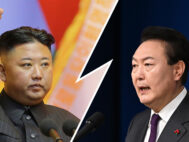
North Korea - South Korea
January — May 2024Mortal Menace, or Mere Mind Games?
Kim Jong Un elaborated his radical new line on South Korea to the Supreme People’s Assembly (SPA) in January. It sounded just as nasty as when he first expounded it in December, but no more coherent. Though obscure, this is clearly very important. Hence most of this article is devoted to a detailed reading of what Kim said, in a bid to tease out what this means in practice for South Korea’s security. While awaiting further specification in a promised Constitutional amendment, our provisional assessment is that this is more bark than bite. Buttressing that view, close analysis of the two Koreas’ artillery shelling near the Northern Limit Line (NLL) in early January, and the barbs they also traded, highlights an element of performativity—especially from Pyongyang—that is somewhat reassuring. Despite much fiery rhetoric, and while vigilance and deterrence remain crucial, this does not look like a peninsula on the brink of war.

North Korea - South Korea
September — December 2023Both Koreas Ditch Their Border Accord
The last third of 2023 was eventful in Korea, especially the two final months. Fall found South Koreans preoccupied with events elsewhere, and their implications for the peninsula. In September, Kim Jong Un’s Siberian summit with Vladimir Putin prompted worries as to how closer Pyongyang-Moscow military ties might affect the ROK. In October, Hamas’ shocking attack on Israel added a new layer of alarm, warranted or otherwise. President Yoon Suk Yeol was among those expressing fear that the DPRK might launch a similar surprise assault. He soon had less hypothetical concerns. In November, in response to Pyongyang’s successful launch (following two earlier failures) of a military reconnaissance satellite, Seoul partially suspended 2018’s inter-Korean military accord—whereupon the North predictably scrapped it entirely. Tensions grew as both sides rearmed at the ironically named Demilitarized Zone (DMZ), and talked tough — none tougher than Kim Jong Un, who spoke openly of occupying the South. As the year ended, Kim declared a major change in DPRK doctrine. Dropping its longstanding lip service to reunification, the North now regards the peninsular situation as “relations between two belligerent states.” The implications of this shift remain to be seen.
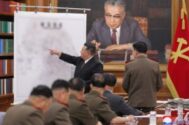
North Korea - South Korea
May — August 2023In Both Pyongyang and Seoul, an Ominous Hardening
In mid-2023, the (non-existent) relations between the two Koreas got even worse, if that were possible. Confronting enlarged US-ROK military exercises, and the first visit of a US nuclear-armed submarine to the peninsula since 1981, Pyongyang’s nuclear threats grew ever more frenzied. In Seoul, President Yoon Suk Yeol institutionalized his hard line by downsizing and repurposing the Ministry of Unification (MOU). Criticizing MOU for acting in the past as a support department for North Korea, Yoon evidently conceives its future role as being to hinder Kim Jong Un’s regime—publicizing its human rights abuses, for instance—rather than help. Much as the DPRK’s ever-expanding WMD threat requires robust deterrence, for Seoul to start emulating Pyongyang’s unalloyed hostility hardly seems conducive to peace. The period under review also saw two attempts by North Korea to put a spy satellite into orbit; both failed. By contrast, the North’s missile launches hardly ever go wrong these days. The large solid-fuel Hwasong-18 ICBM, with a 15,000-km (9,300-mile) range, which first flew in April, had a second successful test on July 12.
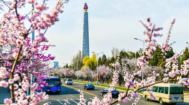
North Korea - South Korea
January — April 2023North Cranks up Nukes—and Slams Down the Phone
The first four months of 2023 brought no progress or respite in inter-Korean relations. Pyongyang sent no further drones into Southern airspace as it had in December, but continued to rattle Seoul with tests of advance weaponry and ever more lurid nuclear rhetoric. South Korea hardened its language and stance, with a restored emphasis on human rights in the North—now officially defined as an enemy once more. ROK President Yoon Suk Yeol also found enemies within: leftists who made contact with the DPRK in third countries were no longer ignored but prosecuted. More ominously, so were four top officials who served the previous president, Moon Jae-in, over how they handled two difficult inter-Korean incidents in 2019-20. Elsewhere, Seoul complained in vain about Pyongyang’s abuse of its assets in two defunct joint ventures: stealing some, destroying others. Soon after, the North stopped answering the phone. It is hard to see how North-South relations will improve, but all too easy to imagine them getting even worse.
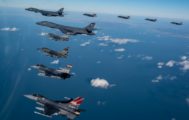
North Korea - South Korea
September — December 2022Drones in a Darkening Sky, Tactical Nuke Talk: Pyongyang’s Provocations Escalate
The main feature of inter-Korean relations in the last four months of 2022 was varied and ever-increasing provocations by Pyongyang. Besides multiple missiles, there were artillery volleys and an incursion by five drones. Kim Jong Un also ramped up his nuclear threats, in theory and practice. A revised law widened the scope of nuclear use, while a new stress on tactical weapons was matched by parading 30 new multiple launch rocket systems (MLRs) which could deliver these anywhere on the peninsula. The government of South Korean President Yoon Suk Yeol for his part reinstated officially calling North Korea an enemy, and revived concern with DPRK human rights. As the year turned, his government was mulling retaliation for the drone incursions; that could include scrapping a 2018 inter-Korean military accord, a dead letter now due to Pyongyang’s breaches. With tensions rising, the new year ahead may be an anxious one on the peninsula.
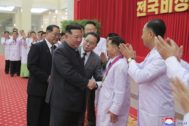
North Korea - South Korea
May — August 2022An Inauspicious Start
On May 10 Yoon Suk Yeol took office as ROK president, and rapidly lost popularity. While talking tough on North Korea, he also offered aid to fight COVID-19—but was ignored. His “audacious plan,” wholly unoriginal, to reward Pyongyang materially if it denuclearizes, had very little detail. For months the DPRK did not even mention Yoon. In late July Kim Jong Un sharply warned him against any pre-emptive strike. In August, his sister Kim Yo Jong put the boot in: ludicrously blaming materials sent by ROK activists for bringing COVID-19 into the DPRK, savaging Yoon’s proposal as insulting and unoriginal, and saying the North will never talk to him. At home, meanwhile, the new government chose to reopen two contentious inter-Korean episodes from the recent past, seemingly to punish its predecessor’s policies. It was hard to see how good could come of that, or to hold out hope for any thaw on the peninsula.

ROUNDTABLE
June 13, 2022Flashpoints in the Indo-Pacific Following the Russian invasion of Ukraine
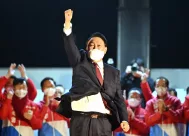
North Korea - South Korea
January — April 2022From Moon to Yoon: End of an Era
The first months of 2022 were also the last of Moon Jae-in’s presidency. Inter-Korean relations have been frozen for the past three years, and 2022 saw no change there. In April Moon exchanged letters with Kim Jong Un, whose warm tenor belied the reality on the ground. The North was already testing more and better missiles faster than ever, and tearing down ROK-built facilities at the shuttered Mount Kumgang resort. Days after his billets-doux with Moon, speaking at a military parade, Kim threatened ominously to widen the contexts in which his ever-improving nuclear arsenal might be used. All these challenges confront a new leader in Seoul. Unlike Moon, the conservative Yoon Suk-yeol is new to politics, but not minded to indulge Kim. His ministerial and other appointees, who have now taken over, are already striking a firmer note—while also stressing their pragmatism and openness to dialogue. Very recently a fresh threat—or perhaps an opportunity—has arisen, with the North finally admitting an outbreak of COVID-19. Yoon promptly offered vaccine aid. It remains to be seen if Kim will accept this, how he will handle the omicron outbreak, whether he will proceed with a widely expected nuclear test, and how Yoon and Biden will handle an ever more complex crisis.
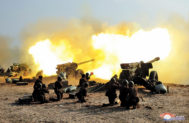
North Korea - South Korea
September — December 2021Waning Moon, Supersonic Kim
Korea’s leaders offered contrasting New Year addresses. While Moon Jae-in pledged to keep pursuing peace until he leaves the Blue House in May, Kim Jong Un said nothing about South Korea or the US. He sent his message soon after, however testing two hypersonic missiles. Moon kept pushing for a peace declaration, despite Washington being lukewarm and Kim Jong Un’s sister Yo Jong saying explicitly that the time is not ripe. Evaluating Moon’s nordpolitik more widely as his term winds down, his refusal to rethink policy after three years of Kim shunning him is puzzling. His successor, whoever it be, will pay Kim less heed. Voters will decide on March 9; the frontrunner is the liberal continuity candidate, Lee Jae-myung. Cocking a snook at both governments, a young gymnast who in late 2020 scaled and jumped border fences to escape from North Korea changed his mind and went back—the same way.